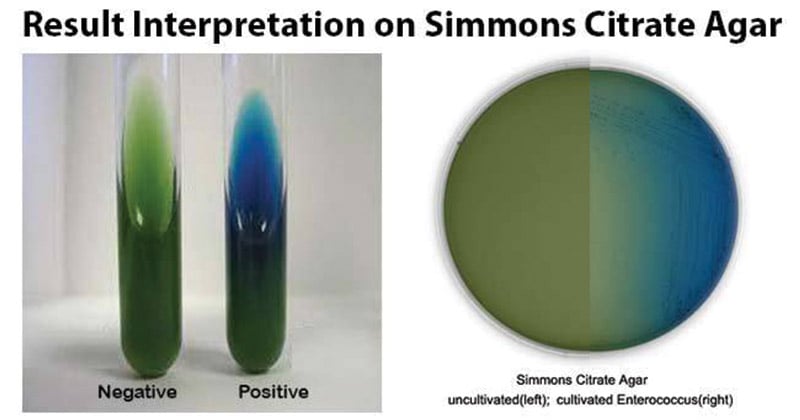Simmons citrate agar is a selective and differential medium that tests for an organism’s ability to use citrate as a sole carbon source and ammonium ions as the sole nitrogen source. It is used for differentiating gram-negative bacteria on the basis of citrate utilization. It is useful for selecting organisms that use citrate as their main carbon and energy source. Initially, the citrate medium was developed by Koser containing ammonium salt as the only nitrogen source and citrate as the only carbon source for differentiating Escherichia coli and Enterobacter aerogenes by IMViC tests. Later on, Simmons modified Koser’s formulation by adding agar and bromothymol blue.
Interesting Science Videos
Composition of Simmons Citrate Agar
| Ingredients | Gms/liter |
| Magnesium sulfate | 0.200 |
| Ammonium dihydrogen phosphate | 1.000 |
| Dipotassium phosphate | 1.000 |
| Sodium citrate | 2.000 |
| Sodium chloride | 5.000 |
| Bromothymol blue | 0.080 |
| Agar | 15.000 |
Final pH ( at 25°C) 6.8±0.2
Principle of Simmons Citrate Agar
Simmons Citrate Agar is used to test an organism’s ability to utilize citrate as a source of energy. Ammonium dihydrogen phosphate and sodium citrate serve as the sole nitrogen and carbon source respectively. Dipotassium Phosphate acts as a buffer. Sodium Chloride maintains the osmotic balance of the medium. Magnesium Sulfate is a cofactor for a variety of metabolic reactions. Bromothymol blue is the pH indicator. Bacteriological Agar is the solidifying agent.
Organisms capable of utilizing ammonium dihydrogen phosphate and citrate will grow unrestricted on this medium. If citrate can be used, the microbe will accumulate alkaline/basic byproducts. Bacteria that can grow on this medium produce an enzyme, citrate-permease, capable of converting citrate to pyruvate. Pyruvate can then enter the organism’s metabolic cycle for the production of energy. Growth is indicative of the utilization of citrate, an intermediate metabolite in the Krebs cycle. The utilization of citrate depends on the presence of an enzyme citrase produced by the organism, that breaks down the citrate to oxaloacetic acid and acetic acid. These products are later converted to pyruvic acid and carbondioxide. The carbondioxide generated combines with sodium and water to form sodium carbonate, an alkaline product. The alkalinity of the medium is indicated by a change in the color of the pH indicator. The shift in pH turns the bromothymol blue indicator in the medium from green to blue above pH 7.6 and this constitutes a positive test.
Preparation of Simmons Citrate Agar
- Suspend 24.28 grams in 1000 ml distilled water.
- Heat, to boiling, to dissolve the medium completely.
- Mix well and distribute in tubes or flasks. For tubes, dispense 4.0 to 5.0 ml into 16-mm tubes.
- Sterilize by autoclaving at 15 lbs pressure (121°C) for 15 minutes.
- Cool in slanted position (long slant, shallow butt).
- Tubes should be stored in a refrigerator to ensure a shelf life of 6 to 8 weeks.
- The uninoculated medium will be a deep forest green due to the pH of the sample and the bromothymol blue.
Result Interpretation on Simmons Citrate Agar

| Result | Observation | Organisms |
| Positive test | – citrate utilization – produces an alkaline reaction – the color of the medium changes from green to bright blue. | Serratia and the majority of the Enterobacter, Citrobacter, Klebsiella, Proteus, and Providencia species |
| Negative test | – no citrate utilization – the color of the medium remains unchanged(green) | Escherichia coli, Shigella, Yersinia, Edwardsiella species, |
Uses of Simmons Citrate Agar
- It is used for the differentiation between Enterobacteriaceae and the members of aerogenes group on the basis of citrate utilization as sole carbon source.
- This agar may be used to differentiate citrate-positive Salmonella enteritidis and members of Salmonella subgenus II, III and IV from the citrate-negative Salmonella typhi, Salmonella paratyphi A, Salmonella pullorum and Salmonella gallinarum.
Limitations of Simmons Citrate Agar
- Before using water, ensure pH of water is 6.5 to 7.0.Initial colour of the medium may deviate from expected colour, if the above precaution is ignored.
- The pH affects the performance of the medium and must be correctly monitored.
- The medium should be freshly prepared because in dry conditions, changes in colour may appear even before inoculation, especially at the bottom of the slant.
- Some organisms are capable of growth on citrate and do not produce a color change. Growth is considered a positive citrate utilization test, even in the absence of a color change.
- The inoculum should be from a pure, overnight culture grown on a solid medium and not from a broth suspension.
- It is recommended that biochemical, immunological, molecular, or mass spectrometry testing be performed on colonies from pure culture for complete identification.
- Failure to incubate tubes with loose caps may result in false-negative results.
- Use a light inoculum to streak the slant; a heavy inoculum may result in false-positive results.
- When inoculating multiple biochemicals from the same culture, inoculate this medium first, or flame inoculating needle prior to streaking this medium. Carryover of glucose or other nutrients onto this medium may result in false-positive results.
References
- Thermo Fisher Scientific Inc., Dehydrated Culture Media- SIMMONS CITRATE AGAR.
- Sisco Research Laboratories Pvt. Ltd.- Simmon’s Citrate Agar (59437).
- Hardy Diagnostics
- Intuitive Systems, Inc.- Simmons’ Citrate Agar Slant.
- Merck Microbiology Manual 12th Edition
- Dalynn Biologicals
- Remel- Citrate Agar (Simmons).
- Sigma-Aldrich, Inc.
- HiMedia Laboratories Pvt. Ltd.- Simmons Citrate Agar (M099).
- Acumedia Manufacturers, Inc.- SIMMONS CITRATE AGAR (7156).
- Neogen Food Safety. Simmons Citrate Agar. http://foodsafety.neogen.com/en/simmons-citrate-agar
- http://www.austincc.edu/microbugz/citrate_test.php
- Atlas R.M and Snyder J.W. 2014. Handbook of Media for Clinical and Public Health Microbiology. CRC Press. Taylor & Francis Group. 6000 Broken Sound Parkway NW, Suite 300 Boca Raton, FL 33487-2742.
- Aneja K.R. 2003. Experiments in Microbiology, Plant Pathology and Biotechnology, fourth revised edition, New Age International (P) limited, Ansari road, Daryaganj, New Delhi-110002.
